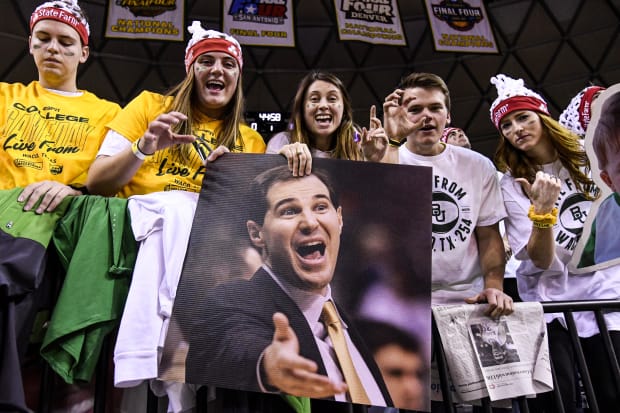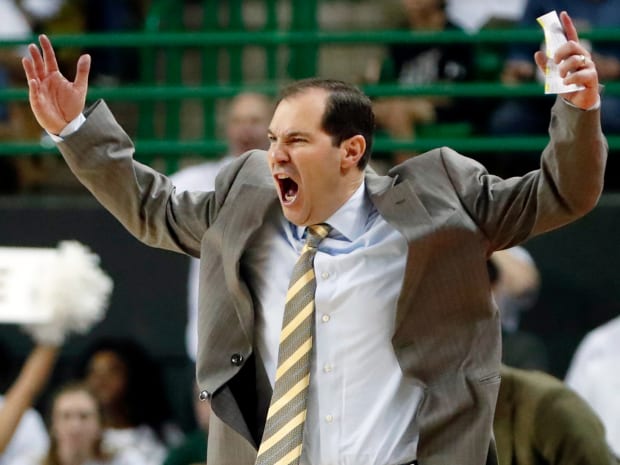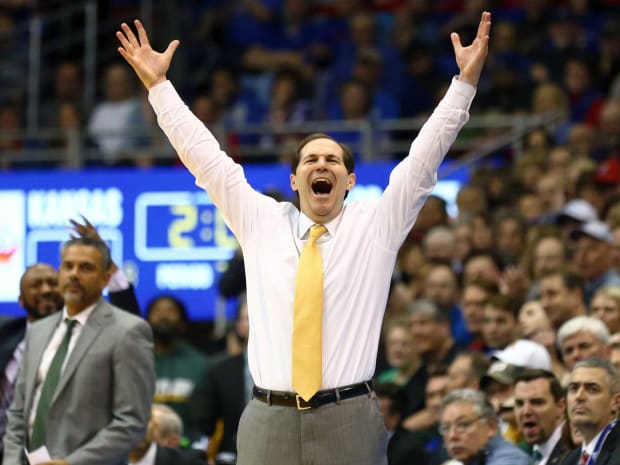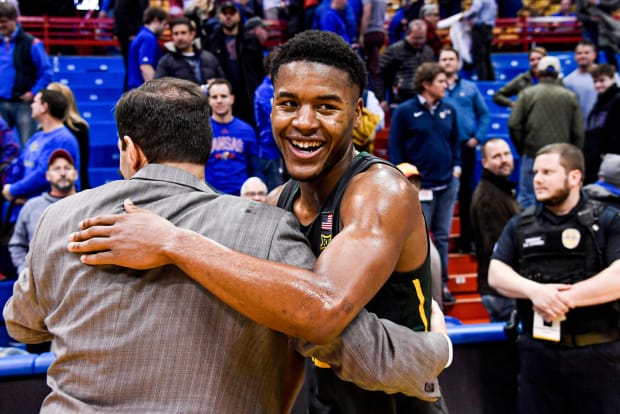New on Sports Illustrated: Being Scott Drew: How College Basketball's Mr. Rogers Turned Baylor Into a Powerhouse
Scott Drew took over Baylor after the darkest scandal in college basketball history. Here's how Drew turned the Bears into one of the year's best teams.
WACO, Texas — Scott Drew doesn’t want to be doing this. He’d rather not have a sitdown interview in his office right now, less than an hour after
his Baylor basketball team’s first loss in 105 days, in the biggest home game in program history. The timing is all wrong.On the table in front of him is the box score from Kansas 64, Baylor 61. There are a few handwritten notes on the paper, the feedback from a quick postgame meeting with his staff. Drew is still wearing his gray suit from the game, tie still cinched tight around his neck, missed free throws and Jayhawks lob dunks still crowding his brain.
He hasn’t let go, and he won’t let go until he’s watched the video at least once, at home, alone, examining the errors that left No. 1 Baylor three points in arrears of No. 3 Kansas. That’s what he’d rather be doing right now.
“I watch it soon as I can after games, especially losses,” Drew said. “Winning’s a little easier. You can put that one off and go get a meal. Losing, it’s usually ride home, shower, then watch it.
“Close games for coaches are the worst. The coach goes over every possession—what could I have done better?”
That self-examination and self-flagellation can wait, though. Today there are a few guests to attend to after hosting the biggest game of the 2019-20 college season nationally, and Drew will do it with a torrent of enthusiasm.
A big part of being Scott Drew is appearing absolutely overjoyed to be doing this interview that he really doesn’t want to be doing. He greets the reporter with a hug—not a half-assed bro hug, but a two-armed, long-lost-relative embrace. He proudly introduces the reporter to former Bear standout Curtis Jerrells, now playing professionally in Italy but back in town for this game. The internal postgame angst has been coated over with a thick veneer of charm.
If it weren’t for the occasional pursed lips and furrowed brow, you’d think Scott Drew is having the time of his life doing this interview he doesn’t want to do after a gut-churning loss. If the interview lasts all day, he’s there for it. There were so many days—months, years—when nobody much cared about his Baylor basketball program, and now the world wants in.
So he’s got the door wide open.
His entire coaching life, Drew has sold hope like it’s a miracle drug. He’s sold it like a true believer, trying to convert the masses into believing in Baylor. He is so over-the-top positive that it’s seen as a negative by some. Is he real or is he a fake?
He comes across as the Mr. Rogers of college basketball, and Mr. Rogers’ neighborhood is not the college hoops neighborhood. It is considerably less neighborly. It is a cutthroat, cynical neighborhood that is at odds with Drew’s public countenance.
“He has an optimism, a sense of faith and a sense of family and togetherness that is real,” said ESPN analyst Fran Fraschilla, a Texas resident who knows the Big 12 better than anyone. “People said early on he’s a phony, he’s a charlatan. But the more you see it, you know it’s real stuff. He’s like that Sunday school preacher, but he believes what he’s preaching. Optimism, with him, is like breathing.”
***

He had a role model, of course. Scott Drew is Homer Drew all over again, a font of positivity on a bigger stage.
“I get it from my dad,” Scott says. “I’m a glass-half-full guy.”
Homer was an assistant coach at LSU from 1972-76, then unplugged himself from the high end of college hoops to become the head coach at NAIA school Bethel College in Indiana. The move was at least in part driven by wanting to spend more time with his young family. After 11 straight winning seasons there, Homer moved to Indiana University-South Bend for one season and then got the head-coaching job at Division I Valparaiso, which also is in northwest Indiana.
Homer Drew was a largely unknown coach at Valpo, a guy who kept his job through five losing seasons to start that tenure in part because he was too nice to fire. Then the program took off in the mid-1990s, an ascendance that coincided with Scott coming to work for Homer as an assistant and younger son Bryce enrolling as a player.
Scott’s playing career is virtually nonexistent, despite being the son of a coach and the oldest sibling to two stars, Bryce and sister Dana. Scott stopped playing basketball after his sophomore season at Valparaiso High School and focused on tennis, hoping to earn a college scholarship in that sport, but it didn’t happen. He played tennis for a couple seasons at Butler but did not earn a varsity letter.
“People ask me if I’m jealous of my brother’s coaching success, having the No. 1 team in the country,” said Bryce Drew, who coached at Valpo and Vanderbilt until being fired in 2019. “He probably got some of those same questions growing up as my brother. But he was always happy for my success as a player, always pushing me to get to the NBA and be as good as I could be.”
Coaching was in Scott’s veins. He worked with Bryce and Dana on some of their youth league teams, and became a student manager for Barry Collier at Butler.
Homer pushed law school. Scott went into the family business instead.
Shortly after Homer, Scott and Bryce came together at Valpo, the program took off. With Scott spearheading an overseas recruiting movement, there were nine straight winning seasons and six NCAA tournament appearances. That run was highlighted by Homer drawing up one of the most famous plays in March Madness lore, resulting in Bryce sinking a game-winning shot at the buzzer to beat Mississippi in the 1998 first round. That Valpo team made the only Sweet 16 appearance in school history.
Along the way, Homer charmed everyone with his pleasant personality. Scott learned more from his dad than just Xs and Os.
“My dad always treated everybody like family,” Scott said. “I think he’s a great man, and I try to emulate that.”
When Homer retired in 2002, Scott was the no-brainer choice to succeed him. It looked like the Drew dynasty would continue at Valpo for many more years, and it did—just not the way anyone envisioned.
***
One year into his Valpo tenure, Scott Drew and assistant Matthew Driscoll were at the annual coaches gathering hosted by David and Dana Pump, college basketball networkers of some renown and notoriety. (There are few clean connections in the sport, and the Pumps have their critics in and around the game.) It was August 2003, and Valpo was coming off a 20-11 season and NIT appearance.
The darkest scandal in NCAA basketball history was simultaneously blowing up at Baylor. On Aug. 8, Dave Bliss was forced to resign as coach of the Bears in the wake of one player (Carlton Dotson) murdering another (Patrick Dennehy). In order to cover up NCAA violations, Bliss concocted a story that smeared Dennehy after his death—alleging that Dennehy was a drug dealer who used the money from those transactions to pay his college tuition, when in fact Bliss had paid him under the table.
Bliss resigned during the Pump outing. Driscoll, in talking to then-NBA coach Tim Floyd at the gathering, found out that Floyd had a connection at Baylor. After a few phone calls, Scott Drew was in play to become the next coach of the Bears.
Driscoll told his boss: “You’re young, you’re Christian and you’re full of energy. And it’s so bad there, you can be bad and still look good because you’re so positive.”
Sounded good in theory, but it would be quite difficult in practice. Bryce Drew attended his brother’s introductory press conference at Baylor and was worried about what Scott had gotten into.
“It wasn’t at ground level,” Bryce said. “It was way below ground level. But I don’t think he ever looked back or had a doubt.”
Scott’s sudden departure freed up Homer to come out of retirement and coach Valpo for another eight seasons. For the first two seasons, at least, Homer had the better team at the mid-major level than Scott had in the Big 12.

Leaving a consistently successful, mom-and-pop operation at Valpo for the cesspool of Baylor looked like career suicide. Scott Drew didn’t see it that way.
“When he left Valpo to go there it looked like a ridiculous move,” Fraschilla said. “Scott inherited one of the worst messes in NCAA history. But he came in with an optimism that was almost naive.”
The naivety was real. Drew came to Waco talking about going to the Final Four and one day winning a national championship. He barely had a program.
“There’s not been a worse situation in college athletics,” said Driscoll, now the head coach at North Florida. “Ever.”
Said Kelly Drew, Scott’s wife: “There were some years going into the season you were just hoping to get a win in the Big 12. One win.”
Their first Baylor team had six scholarship players. Taking over a program in August, just a couple of months before the season started, they were so desperate for bodies that they held an open tryout on campus. Turnout was surprisingly robust.
“I was so excited,” Drew said. “Our staff and I walked in and there are a lot of good-looking athletes.”
The only problem—many of them weren’t Baylor students. They heard about a tryout and came to campus thinking they could join the team without being enrolled.
The search for players even extended to a Fazoli’s one day. Drew and Driscoll were there for lunch when they saw a 6-foot-7, athletic-looking young man, so they asked him if he was a Baylor student. The guy said he was a sophomore at the school, and the coaches told him to come by their offices and talk to them about joining the team.
They never saw him again. After scouring the dorms looking for him, Drew and Driscoll figured out he wasn’t a student after all.
Baylor not only had no players and a major NCAA investigation ongoing, there were few other trappings of a big-time basketball program. The locker room was archaic, the transportation was modest, the budget was small.
“We took charters to Lubbock,” Driscoll quipped. “But they were buses, not a plane.”
The job got tougher two years in, when the NCAA hammered Baylor for Bliss’ sins. Among the penalties: the Bears couldn’t play any non-conference games in the 2005-06 season. Their first game was Jan. 11, and they went 4-13 against a Big 12-only schedule.
Drew was undaunted. Playing from way behind and unwilling to take as long to rebuild as most people expected, he embarked on a two-pronged recruiting strategy: players and donors. He relentlessly attacked both, speaking to every Baylor alumni group he could find and chasing on-court talent everywhere.
Donations were raised to buy a golf cart for whisking recruits around campus. More money was raised for a smoked-glass door in the locker room, in hopes of trying to make it look better. (“We had nothing else to sell,” Driscoll said.) Finally, a donor was lined up to remodel the whole locker room, which freed up the staff to get more creative in other areas.
Baylor arranged an elaborate and intricately video presentation for recruits when they came into Drew’s office. Once the lights were flipped on, a 17-second timer starter that gave coaches the chance to get a recruit to the couch. Then the lights would dim, a screen would raise up and a highlight reel would play, tailored to that specific recruit.
“Everything was recruiting,” Driscoll said. “Coach always said, ‘We can be the best coaches in the world but we’re not going to win without talent.’ “
Drew tried everything to make Baylor trendy. He asked the car dealer that supplied the staff’s cars to put tricked-up rims on Driscoll’s car. Driscoll, 43 years old at the time, protested.
“He said, ‘Drisc, kids love rims. Get the rims,’“ Driscoll recalled. “I got the rims. The were pretty nice."
After four straight losing seasons, Drew finally had his breakthrough. In 2007-08, the Bears won 20 games in a season for the first time in 20 years and Drew scheduled a Selection Sunday watch party for the team and fans. CBS sent a film crew to the party in anticipation of an NCAA tournament bid.
As the selection show unfolded, Baylor’s excitement turned to dread. Pairing after pairing was revealed, and there was no sign of the Bears. Finally, as the last pairing was about to be revealed, Driscoll saw the CBS camera man go to flip on the light on his camera and knew—Baylor was in.
“My heart and my adrenaline went straight uphill,” Driscoll said. “I don’t know if I ever cried so quickly or so long.”
***

Baylor’s success did not come without side effects. Drew recruited aggressively against the other powers in the state, taking some shots that were not well received. He sent a flier to recruits that featured a picture of Drew standing between then-Texas Tech coach Bob Knight and then-Texas A&M coach Billy Gillispie, with the caption: “Which of these Big 12 coaches has signed a McDonald’s All-American?” There were red Xs covering the pictures of Knight and Gillispie.
Knight got in Drew’s face about that at Big 12 media days, and then-Texas coach Rick Barnes also fired publicly at Drew. “There’s a long line that he knows he can’t cross with me,” Barnes said. Coaches around the country rolled their eyes when Drew hired AAU coach Dwon Clifton in an unconcealed attempt to land superstar John Wall. (It didn’t work, he went to Kentucky.)
Drew wound up apologizing for the flier, but not for his overall approach. He was going to keep mixing it up.
The aggressive approach soon begat a new tag: cheater. The more big-time recruits Drew landed, the more people in his profession were sure he was cutting corners. In 2012, the NCAA caught up to Drew and Baylor women’s coach Kim Mulkey, sanctioning them for impermissible phone calls to recruits. Drew was suspended for the first two Big 12 games of the 2012-13 season, and the program was put on three years’ probation.
The NCAA hit was all the proof some critics needed to label Drew a phony—an outspoken Christian in public and a guy cutting corners in private. But there have been no major NCAA issues since then, and the success has continued.
“He overdid it with the relentless recruiting,” Fraschilla said. “He did some things that rubbed people the wrong way. No question, he’s matured over his 17 years (at Baylor).”
Those who didn’t like Drew could at least take solace in one thing: even with all the talent he was bringing in, the Bears weren’t getting to the Final Four. He made regional finals in 2010 and ’12, but lost both times to the eventual national champion (Duke in ’10 and Kentucky in ’12). There were some other early tourney flameouts.
Thus the storyline was altered again—Scott Drew could recruit, but he couldn’t coach. He was a lightweight on the sidelines with a gimmick zone defense who would get exposed in the caldron of tournament pressure.
Eventually, Drew altered his recruiting approach—he chased fewer five-stars and more developmental prospects who competed with a hunger that helped compensate for any lack of talent. He combed the transfer market for players who would fit his program. He embraced the new roster management mantra for college basketball success in the one-and-done era: get old and stay old.
“It’s not quite Villanova, but it’s Villanova-esque,” Fraschilla said. “They’ve done a tremendous job of player development, and identifying guys who fit what they do.
“I was one of those guys early on who wasn’t sure how good a coach he was. But the Scott Drew Can’t Coach Crew has left the station. They’re gone. There’s absolutely a healthy respect for him in the league as a coach. I don’t even think it’s grudging respect anymore.”
This year’s team is Drew’s coaching masterpiece. A roster that features a Division III transfer (big man Freddie Gillespie), a transfer from UNC-Asheville (MaCio Teague), a transfer from Auburn (Davion Mitchell) and a couple of steals from the state of Louisiana (Mark Vital and Jared Butler) pieced together a 23-game winning streak and took Baylor to the top of the polls for several weeks.
Along the way, a guy known for his zone defense threw that out and has played man-to-man almost the entire season. Drew simply believed his current personnel—shorter, more athletic—is better suited to man than zone. The decision has proved prescient; this is the best defensive team Drew has ever had.
The regular season built to a crescendo last Saturday in Waco. ESPN’s College GameDay show came to town. So did a dozen former Bears players. Baylor super fans Chip and Joanna Gaines, the husband-and-wife power couple behind the Magnolia home decor franchise, were in the house as well.
It was the biggest show ever to hit Baylor basketball. It fell just short of perfect when Kansas beat the Bears. And now Scott Drew is sitting in his office entertaining visitors, when all he really wants to do is go home and watch game film.
***

There will be pressure this March. More pressure than Drew and Baylor have ever experienced. The Bears are a near-lock for their first-ever No. 1 seed, and expectations of their first Final Four in 70 years will be justifiably high.
If Drew accomplishes that career-validating milestone, you’d think a more basketball-centric school might throw a massive payday at a 49-year-old who is just now hitting his coaching prime. But even after 17 years, this might be the only job Scott Drew needs. An outspoken Christian at a Baptist school, in charge of a program he personally raised from the rubble.
“Scott fits like a glove,” Fraschilla said. “I’m not sure he can wear his faith on his sleeve like he does if he’s at Michigan or Maryland or some other places. He fits Central Texas like Chip and Joanna. It’s perfect.”
The postgame office interview is finally over, but Scott Drew still doesn’t want to rush his visitor out. Anything else he can do? How about a Baylor basketball T-shirt?
It's time for a goodbye hug. Both arms. The Mr. Rogers of college basketball hopes you enjoyed the visit to his neighborhood.
Comments
Post a Comment